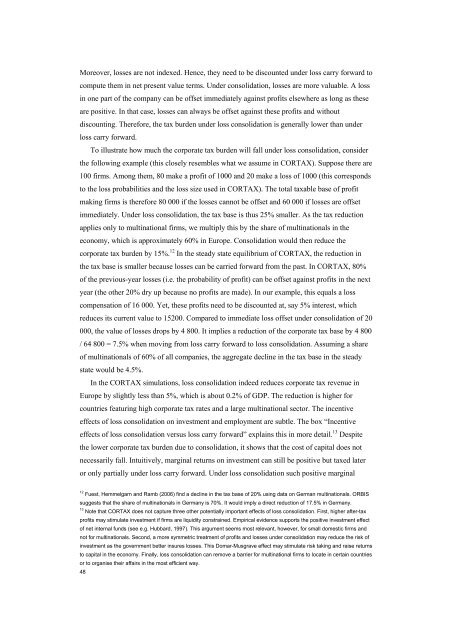The economic effects of EU-reforms in corporate income tax systems
The economic effects of EU-reforms in corporate income tax systems
The economic effects of EU-reforms in corporate income tax systems
You also want an ePaper? Increase the reach of your titles
YUMPU automatically turns print PDFs into web optimized ePapers that Google loves.
Moreover, losses are not <strong>in</strong>dexed. Hence, they need to be discounted under loss carry forward to<br />
compute them <strong>in</strong> net present value terms. Under consolidation, losses are more valuable. A loss<br />
<strong>in</strong> one part <strong>of</strong> the company can be <strong>of</strong>fset immediately aga<strong>in</strong>st pr<strong>of</strong>its elsewhere as long as these<br />
are positive. In that case, losses can always be <strong>of</strong>fset aga<strong>in</strong>st these pr<strong>of</strong>its and without<br />
discount<strong>in</strong>g. <strong>The</strong>refore, the <strong>tax</strong> burden under loss consolidation is generally lower than under<br />
loss carry forward.<br />
To illustrate how much the <strong>corporate</strong> <strong>tax</strong> burden will fall under loss consolidation, consider<br />
the follow<strong>in</strong>g example (this closely resembles what we assume <strong>in</strong> CORTAX). Suppose there are<br />
100 firms. Among them, 80 make a pr<strong>of</strong>it <strong>of</strong> 1000 and 20 make a loss <strong>of</strong> 1000 (this corresponds<br />
to the loss probabilities and the loss size used <strong>in</strong> CORTAX). <strong>The</strong> total <strong>tax</strong>able base <strong>of</strong> pr<strong>of</strong>it<br />
mak<strong>in</strong>g firms is therefore 80 000 if the losses cannot be <strong>of</strong>fset and 60 000 if losses are <strong>of</strong>fset<br />
immediately. Under loss consolidation, the <strong>tax</strong> base is thus 25% smaller. As the <strong>tax</strong> reduction<br />
applies only to mult<strong>in</strong>ational firms, we multiply this by the share <strong>of</strong> mult<strong>in</strong>ationals <strong>in</strong> the<br />
economy, which is approximately 60% <strong>in</strong> Europe. Consolidation would then reduce the<br />
<strong>corporate</strong> <strong>tax</strong> burden by 15%. 12 In the steady state equilibrium <strong>of</strong> CORTAX, the reduction <strong>in</strong><br />
the <strong>tax</strong> base is smaller because losses can be carried forward from the past. In CORTAX, 80%<br />
<strong>of</strong> the previous-year losses (i.e. the probability <strong>of</strong> pr<strong>of</strong>it) can be <strong>of</strong>fset aga<strong>in</strong>st pr<strong>of</strong>its <strong>in</strong> the next<br />
year (the other 20% dry up because no pr<strong>of</strong>its are made). In our example, this equals a loss<br />
compensation <strong>of</strong> 16 000. Yet, these pr<strong>of</strong>its need to be discounted at, say 5% <strong>in</strong>terest, which<br />
reduces its current value to 15200. Compared to immediate loss <strong>of</strong>fset under consolidation <strong>of</strong> 20<br />
000, the value <strong>of</strong> losses drops by 4 800. It implies a reduction <strong>of</strong> the <strong>corporate</strong> <strong>tax</strong> base by 4 800<br />
/ 64 800 = 7.5% when mov<strong>in</strong>g from loss carry forward to loss consolidation. Assum<strong>in</strong>g a share<br />
<strong>of</strong> mult<strong>in</strong>ationals <strong>of</strong> 60% <strong>of</strong> all companies, the aggregate decl<strong>in</strong>e <strong>in</strong> the <strong>tax</strong> base <strong>in</strong> the steady<br />
state would be 4.5%.<br />
In the CORTAX simulations, loss consolidation <strong>in</strong>deed reduces <strong>corporate</strong> <strong>tax</strong> revenue <strong>in</strong><br />
Europe by slightly less than 5%, which is about 0.2% <strong>of</strong> GDP. <strong>The</strong> reduction is higher for<br />
countries featur<strong>in</strong>g high <strong>corporate</strong> <strong>tax</strong> rates and a large mult<strong>in</strong>ational sector. <strong>The</strong> <strong>in</strong>centive<br />
<strong>effects</strong> <strong>of</strong> loss consolidation on <strong>in</strong>vestment and employment are subtle. <strong>The</strong> box “Incentive<br />
<strong>effects</strong> <strong>of</strong> loss consolidation versus loss carry forward” expla<strong>in</strong>s this <strong>in</strong> more detail. 13 Despite<br />
the lower <strong>corporate</strong> <strong>tax</strong> burden due to consolidation, it shows that the cost <strong>of</strong> capital does not<br />
necessarily fall. Intuitively, marg<strong>in</strong>al returns on <strong>in</strong>vestment can still be positive but <strong>tax</strong>ed later<br />
or only partially under loss carry forward. Under loss consolidation such positive marg<strong>in</strong>al<br />
12 Fuest, Hemmelgarn and Ramb (2006) f<strong>in</strong>d a decl<strong>in</strong>e <strong>in</strong> the <strong>tax</strong> base <strong>of</strong> 20% us<strong>in</strong>g data on German mult<strong>in</strong>ationals. ORBIS<br />
suggests that the share <strong>of</strong> mult<strong>in</strong>ationals <strong>in</strong> Germany is 70%. It would imply a direct reduction <strong>of</strong> 17.5% <strong>in</strong> Germany.<br />
13 Note that CORTAX does not capture three other potentially important <strong>effects</strong> <strong>of</strong> loss consolidation. First, higher after-<strong>tax</strong><br />
pr<strong>of</strong>its may stimulate <strong>in</strong>vestment if firms are liquidity constra<strong>in</strong>ed. Empirical evidence supports the positive <strong>in</strong>vestment effect<br />
<strong>of</strong> net <strong>in</strong>ternal funds (see e.g. Hubbard, 1997). This argument seems most relevant, however, for small domestic firms and<br />
not for mult<strong>in</strong>ationals. Second, a more symmetric treatment <strong>of</strong> pr<strong>of</strong>its and losses under consolidation may reduce the risk <strong>of</strong><br />
<strong>in</strong>vestment as the government better <strong>in</strong>sures losses. This Domar-Musgrave effect may stimulate risk tak<strong>in</strong>g and raise returns<br />
to capital <strong>in</strong> the economy. F<strong>in</strong>ally, loss consolidation can remove a barrier for mult<strong>in</strong>ational firms to locate <strong>in</strong> certa<strong>in</strong> countries<br />
or to organise their affairs <strong>in</strong> the most efficient way.<br />
48
















